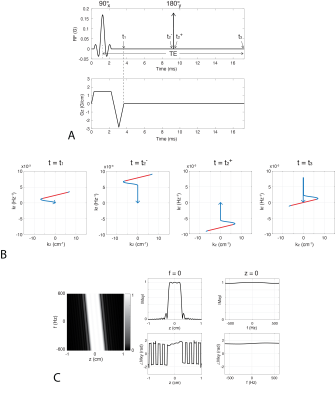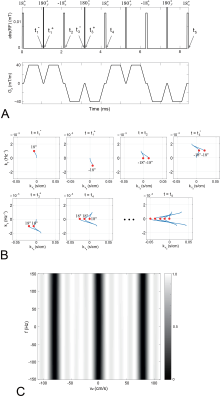2929
Extension of k-space formalism with refocusing RF pulses1Weill Cornell Medicine, New York, NY, United States, 2Division of Mechanical and Biomedical Engineering, Ewha Womans University, Seoul, Korea, Republic of, 3Graduate Program in Smart Factory, Ewha Womans University, Seoul, Korea, Republic of, 4Department of Medicine, Case Western Reserve University, Cleveland, OH, United States
Synopsis
Conventional k-space analysis of excitation based on Fourier relationship between excitation profile and RF deposit in k-space is extremely useful for pulse sequence design but is strictly limited to the small-tip-angle regime. We propose a new theoretical viewpoint for including refocusing pulses in the k-space formalism and demonstrate that the effect of refocusing pulse can be viewed as origin symmetric rotation of RF deposit in k-space. This new viewpoint may enable analytic approaches to designing RF pulses with multiple refocusing pulses and offer new opportunities to develop complex RF pulses that require insensitivity to off-resonance.
Introduction
In the conventional excitation k-space formalism, only small tip angles are allowed for excitation. Here we present a new viewpoint for including 180° refocusing pulses in the excitation k-space to provide insights into the effects of refocusing pulses on off-resonance sensitivity. Spin echo pulse and refocused velocity-selective excitation pulse are explained by the proposed extended k-space formalism.Theory
As shown in previous work [1,2], there is Fourier relationship between transverse magnetization Mxy and RF (with duration of T) deposited in multi-dimensional excitation k-space where the trajectory is determined by gradient waveforms and time:$$M_{xy}=jγM_0 \int_{\bf K}p({\bf k}) e^{-j2π\bf{k}\cdot\bf x} d{\bf k},$$
where
$$p({\bf k})=\int_0^TB_1(t)δ({\bf k}(t)-{\bf k})dt,\\{\bf x}=[x\;\; y\;\; z\;\; f]^T,\\{\bf k}=[k_x\;\; k_y\;\; k_z\;\; k_f ]^T,\\{\bf k}(t)=[k_x(t)\;\; k_y(t)\;\; k_z(t)\;\; k_f(t)]^T,\\k_{x,y,z} (t)=\frac{γ}{2π}∫_t^TG_{x,y,z} (s)ds,\\k_f (t)=T-t.$$
Suppose that B1(t) consists of multiple small-tip-angle subpulses within its duration of T, including one refocusing pulse at time T0 (0 < T0 < T). Immediately prior to the refocusing pulse (denoted by time T0-), Mxy can be written as:
$$M_{xy} (T_0^-)=jγM_0∫_{\bf K}p_0 ({\bf k})e^{-j2π{\bf k}\cdot{\bf x}} d{\bf k},$$
where
$$p_0({\bf k})=\int_0^{T_0^-}B_1(t)δ({\bf k}(t)-{\bf k})dt.$$
We assume that refocusing pulses are instantaneous for this k-space analysis. We describe the analysis for two different cases of refocusing pulse: rotation along x- and y-axis.
(i) Refocusing pulse along the x-axis:
The phase of Mxy at time T0- denoted by ϕ is changed to -ϕ at time T0+, which is immediately after the refocusing pulse. Therefore, Mxy(T0+) equals the complex conjugate of Mxy(T0-).
$$M_{xy} (T_0^+)=M_{xy}^* (T_0^- )=(-j)γM_0 ∫_{\bf K}p_0^* ({\bf k})e^{j2π{\bf k}\cdot{\bf x}} d{\bf k}.$$
Assuming that B1(t) is real at all times (i.e. applied along the x-axis only), p0*(k) = p0(k).
$$M_{xy} (T_0^+)=jγM_0 ∫_{\bf K}-p_0 ({\bf k})e^{-j2π(-{\bf k}\cdot{\bf x})} d{\bf k}.$$
This can be rewritten using k'=-k.
$$M_{xy} (T_0^+ )=jγM_0 ∫_{-{\bf K}}-p_0 (-{\bf k'})e^{-j2π{\bf k'}\cdot{\bf x}} (-d{\bf k'})=jγM_0 ∫_{\bf K}-p_0 (-{\bf k'})e^{-j2π{\bf k'}\cdot{\bf x}} d{\bf k'}.$$
Now k' can be changed back to k.
$$M_{xy} (T_0^+ )=jγM_0 ∫_{\bf K}-p_0 (-{\bf k})e^{-j2π{\bf k}\cdot {\bf x}} d{\bf k}.$$
This is still a form of Fourier transform of weighted k-space trajectory although the k-space weight is now determined by $$$p_0 (-{\bf k})=\int_{0}^{T_0^-}B_1(t)δ({\bf k}(t)+{\bf k})dt$$$, which corresponds to the origin symmetry of $$$p_0 ({\bf k})=\int_{0}^{T_0^-}B_1(t)δ({\bf k}(t)-{\bf k})dt$$$ in excitation k-space. Note that -1 is multiplied to $$$p_0 (-{\bf k})$$$ in the equation above, which indicates the sign change of the B1(t) deposited for 0 < t < T0. The rest of B1(t) (T0 < t < T) can continue to be deposited in k-space after the origin symmetric conversion of the B1(t) deposited for 0 < t < T0. However, after the refocusing pulse, magnetization is near the south pole (Mz < 0), and the effect of small tip α on Mxy is now -sin(α) instead of sin(α). Therefore, RF weight for T0 < t < T should be considered to be -B1(t) in the k-space analysis. Together with -1 multiplied to B1(t) for 0 < t < T0, this leads to multiplication of -1 to the entire B1(t) (0 < t < T) in k-space analysis. Mxy at the end of excitation pulse sequence is
$$M_{xy} (T)=-jγM_0 ∫_{\bf K}p ({\bf k})e^{-j2π{\bf k}\cdot{\bf x}} d{\bf k},$$
where
$$p({\bf k})=∫_0^{T} \widehat {B}_1(t)δ({\bf k}(t)-{\bf k})dt,\\\widehat {B}_1(t)=B_1(t)\text { without refocusing pulse},\\{\bf k}(t)=[k_x(t)\;\; k_y(t)\;\; k_z(t)\;\; k_f(t)]^T,\\k_{x,y,z} (t)=\frac{γ}{2π}∫_t^T\widehat{G}_{x,y,z} (s)ds,\\\widehat{G}_{x,y,z} (t)=\begin{cases}-G_{x,y,z} (t) & t≤T_0\\G_{x,y,z} (t) & t>T_0\end{cases},\\k_f (t)=-|t-T_0 |+T-T_0.$$
For RF pulses with multiple refocusing pulses, origin symmetric conversion should continue to be applied in k-space at each time point of refocusing pulse while non-refocusing RF pulses are deposited in k-space. Also, Mxy from RF pulse with n refocusing pulses will include a multiplier of (-1)n. This sign change, however, may be ignored because the sign of Mxy is not usually included in design parameters.
(ii) Refocusing pulse along the y-axis:
The phase of Mxy at time T0-, ϕ is changed to π-ϕ at time T0+. Therefore,
$$M_{xy} (T_0^+ )=e^{jπ} M_{xy}^* (T_0^- )=-M_{xy}^* (T_0^-).$$
Note that there is an additional term of -1 here. This is different from the sign change described above. Mxy profile with refocusing along the y-axis will still include aforementioned sign change (i.e., (-1)n with n refocusing pulses), which again can be ignored. However, the additional term of -1 in the equation above imposes another sign change on the pre-deposited B1(t). This sign change cannot be neglected because it reverses the sign of only parts of RF sequence (not entire RF sequence) and affects the shape of Mxy profile substantially. In general, if an RF pulse includes n refocusing pulses along the y-axis at time t1, t2, … tn, the sign of B1(t) deposited in k-space will be reversed for tn > t ≥ tn-1, tn-2 > t ≥ tn-3, tn-4 > t ≥ tn-5, and so on. Figure 1 and 2 illustrate examples of k-space analysis with refocusing pulses.
Discussion
We have proposed a new theoretical viewpoint for analyzing the effects of 180° refocusing pulses using excitation k-space, which was originally valid only in the small-tip-angle regime. This viewpoint may offer opportunities to design new complex RF pulse sequences with multiple refocusing pulses that require insensitivity to off-resonance in applications such as velocity-selective arterial spin labeling or velocity-selective angiography [3,4,6].Acknowledgements
R01HD100012, R01HL135500References
1. Pauly J, Nishimura D, Macovski A. A k-space analysis of small-tip-angle excitation. J Magn Reson. 1989;81:43-56.
2. Shin T, Worters PW, Hu BS, Nishimura DG. Non-contrast-enhanced renal and abdominal MR angiography using velocity-selective inversion preparation. Magn Reson Med. 2013;69:1268-1275.
3. Shin T, Hu BS, Nishimura DG. Off-resonance-robust velocity-selective magnetization preparation for non-contrast-enhanced peripheral MR angiography. Magn Reson Med. 2013;70:1229-1240.
4. Qin Q, Shin T, Schär M, Guo H, Chen H, Qiao Y. Velocity-selective magnetization-prepared non-contrast-enhanced cerebral MR angiography at 3 Tesla: Improved immunity to B0/B1 inhomogeneity. Magn Reson Med. 2016;75:1232-1241.
5. de Rochefort L, Maître X, Bittoun J, Durand E. Velocity-selective RF pulses in MRI. Magn Reson Med. 2006;55:171-176.
6. Wong EC, Cronin M, Wu WC, Inglis B, Frank LR, Liu TT. Velocity-selective arterial spin labeling. Magn Reson Med. 2006;55:1334-1341.
Figures

